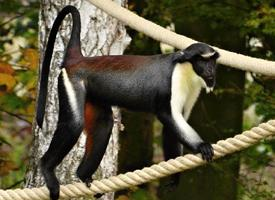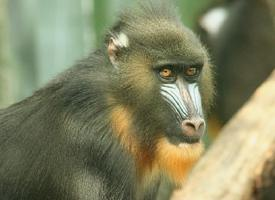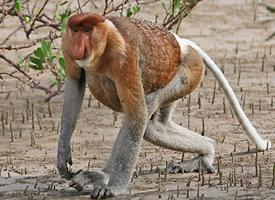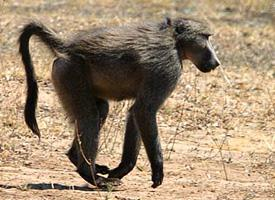
Váhy a míry
| Délka | od 40 do 55 cm |
|---|---|
| Hmotnost | od 4 do 7 kg |
| Délka ocasu | od 50 do 75 cm |
Biologická data
| Délka života | 20 r |
|---|---|
| Délka březosti | 5 m |
| Počet mláďat | 1 |
Stav ohrožení
| Ohrožen |
Popis zvířete
The Diana monkey (Cercopithecus diana) is a visually striking and ecologically important primate species native to the West African rainforests, primarily found in countries such as Sierra Leone, Liberia, Ivory Coast, and Ghana. This species is named after the Roman goddess Diana, reflecting its graceful and noble appearance.Physical Characteristics:
The Diana monkey is known for its distinctive coat pattern and coloration, which not only adds to its beauty but also serves as camouflage in the dense forest habitat. Adults typically exhibit a predominantly black or dark grey fur, with a white throat, crescent-shaped brow band, rump, and beard, which starkly contrast against the darker tones of their body. Their cheeks are adorned with white fur that stretches towards the ears, creating a striking appearance. A unique feature of their coat is the orange or chestnut patch found on their back, which varies in intensity among individuals. Adult Diana monkeys can weigh between 4 to 7 kg, with males generally being larger and more robust than females.
Behavior and Social Structure:
Diana monkeys are diurnal and arboreal, spending most of their time in the trees. Their social structure is centered around multi-male, multi-female groups, typically comprising 15 to 30 individuals, although larger groups are not uncommon. These groups are complex, with a clear hierarchical structure based on age, sex, and strength. Males display territorial behavior, vocalizing loudly to assert dominance and defend their territory against rivals.
Diet:
Their diet is omnivorous but primarily consists of fruits, seeds, leaves, and occasionally small animals such as insects and birds. This varied diet plays a crucial role in the seed dispersal of many tree species, contributing to the health and diversity of their forest habitat.
Communication:
Diana monkeys are known for their rich repertoire of vocalizations, which they use to communicate with each other within the dense forests. Their calls can convey a wide range of information, including alarm signals specific to different types of predators such as leopards, crowned eagles, and snakes. This ability to produce predator-specific calls suggests a high level of cognitive ability and social cooperation among Diana monkeys.
Conservation Status:
The Diana monkey is currently listed as Vulnerable by the International Union for Conservation of Nature (IUCN). Their populations are threatened by habitat destruction due to logging, agricultural expansion, and human settlement. Additionally, they are hunted for bushmeat and captured for the illegal pet trade. Conservation efforts are crucial to protect this species and its habitat, including establishing and enforcing protected areas, promoting sustainable land-use practices, and raising awareness about the importance of biodiversity conservation.
In summary, the Diana monkey is not only a symbol of the rich biodiversity found in West African forests but also plays a vital role in the ecosystem. Its striking appearance, complex social structure, and diverse diet make it a fascinating subject of study for primatologists and conservationists alike. Protecting this species and its habitat is essential for maintaining the ecological balance and ensuring the survival of the Diana monkey for future generations.
Podobná zvířata
Nové fotografie zvířat
Top 10 zvířat
- Chinese water dragon (Physignathus cocincinus)
- Galápagos tortoise (Geochelone nigra complex)
- Sea urchins (Echinoidea)
- Diana monkey (Cercopithecus diana)
- Dolphin gull (Leucophaeus scoresbii)
- Moustached guenon (Cercopithecus cephus)
- Japanese macaque (Macaca fuscata)
- Royal penguin (Eudyptes schlegeli)
- Hen harrier (Circus cyaneus)
- Barbary macaque (Macaca sylvanus)


